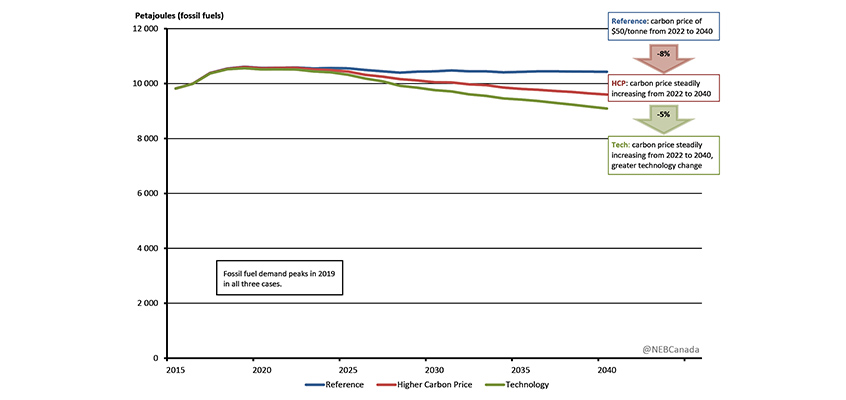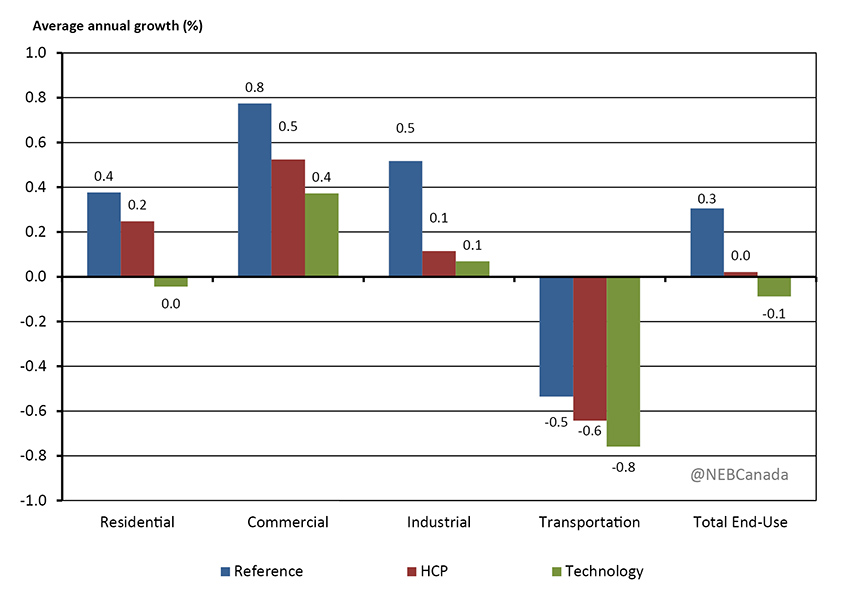ARCHIVED – Fact Sheet - Canada’s Energy Future 2017: Energy Supply and Demand Projections to 2040 - Energy Consumption
This page has been archived on the Web
Information identified as archived is provided for reference, research or recordkeeping purposes. It is not subject to the Government of Canada Web Standards and has not been altered or updated since it was archived. Please contact us to request a format other than those available.
Total Fossil Fuel Demand
- Total fossil fuel demand includes the natural gas, coal, and oil products used in the end-use sectors, as well as the fossil fuels used to generate electricity.
- In the Reference Case, fossil fuel consumption increases early in the projection period. By 2019 consumption peaks and is relatively flat through the remainder of the projection period and is slightly lower than 2019 levels by 2040. Fossil fuel consumption in 2040 is 4.3% higher than in 2016, and nearly 9% higher than in 2005.
- In the Higher Carbon Pricing (HCP) Case, fossil fuel consumption also peaks in 2019 and declines more quickly compared to the Reference Case. Fossil fuel consumption in 2040 is 4% lower than in 2016, and is nearly the same as in 2005.
- In the Technology Case, carbon pricing plus the impact of select emerging technologies causes fossil fuel demand to decline faster than the HCP Case. By 2040, total fossil fuel use in the Technology Case is 13% less than the Reference Case, and 5% less than the HCP Case.
Fossil Fuel Use, All Cases

Total Energy Demand
- In the Reference Case, the share of renewable and nuclear energy combined in the total energy mix remains near historical levels. They make up 36% of total primary demand by 2040. In the other cases this share rises, due to increasing demand for these sources, and declining use of fossil fuels. In 2040, renewable and nuclear energy makes up 39% of the energy mix in the HCP Case, and 43% of the energy mix in the Technology Case.
- Energy intensity, measured as total energy use per dollar of gross domestic product, declines in all three cases. From 2016 to 2040, intensity declines 30% in the Reference Case, 35% in the HCP Case, and 37% in the Technology Case.
End-Use Energy Demand by Sector
- End-use energy demand includes the electricity, fossil fuels, and renewables used in the residential, commercial, industrial, and transportation sectors. It excludes the energy used to generate electricity.
- Compared to the 1990-2015 period, when demand grew by an average of 1.2% per year, end-use energy demand in the Reference Case grows considerably more slowly over the outlook period, averaging growth of 0.3% per year. Reasons for this include: slower economic and population growth than history, improving energy efficiency, the impact of the Pan-Canadian approach for pricing carbon, and other policies, programs, and regulations.
- In the HCP Case, end-use demand is near 2016 levels by 2040. As carbon pricing rises in the longer term, consumers use less energy and invest in more fuel efficient technology.
- The technologies considered in the Technology Case impact energy use in a variety of ways, and result in a decrease in end-use energy demand. Total end-use demand in 2040 in the Technology Case is 2.6% lower than in the HCP Case and 9% lower than in the Reference Case.
Projected Annual Average Growth in End-Use Energy Demand by Sector, 2016 to 2040, All Cases

- Date modified:
